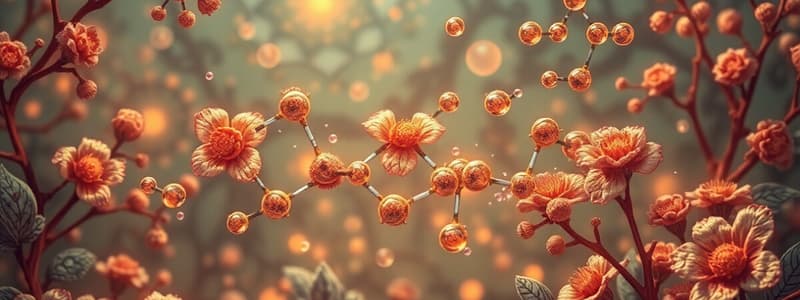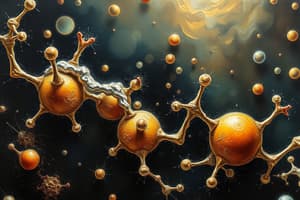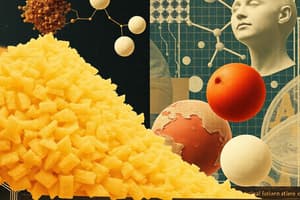Podcast
Questions and Answers
What is the general chemical formula for carbohydrates?
What is the general chemical formula for carbohydrates?
- C2H4O3
- (CH2O)n (correct)
- (CH3O)n
- C2H4O2
Which of the following is NOT a function of carbohydrates in living organisms?
Which of the following is NOT a function of carbohydrates in living organisms?
- Structural support
- Genetic information storage (correct)
- Cell signaling
- Energy storage
Which of the following is an example of a disaccharide?
Which of the following is an example of a disaccharide?
- Glycogen
- Sucrose (correct)
- Starch
- Glucose
What property of fatty acids allows them to form cell membranes?
What property of fatty acids allows them to form cell membranes?
Which of the following is a characteristic of saturated fatty acids?
Which of the following is a characteristic of saturated fatty acids?
Which of the following accurately describes a characteristic of a colloid?
Which of the following accurately describes a characteristic of a colloid?
Which of the following is NOT a characteristic of solutions?
Which of the following is NOT a characteristic of solutions?
Which of the following best describes a suspension?
Which of the following best describes a suspension?
Which type of mixture is characterized by particles that do not pass through cell membranes?
Which type of mixture is characterized by particles that do not pass through cell membranes?
Which of the following is a key characteristic of a base?
Which of the following is a key characteristic of a base?
What is the role of buffers in biological systems?
What is the role of buffers in biological systems?
Which of the following processes uses water to break bonds?
Which of the following processes uses water to break bonds?
What is the significance of carbon's ability to form four covalent bonds?
What is the significance of carbon's ability to form four covalent bonds?
What is the primary reason why minerals are important for enzyme structure and function?
What is the primary reason why minerals are important for enzyme structure and function?
What is the main difference between nonpolar covalent bonds and polar covalent bonds?
What is the main difference between nonpolar covalent bonds and polar covalent bonds?
Which of the following is NOT a characteristic of ionic bonds?
Which of the following is NOT a characteristic of ionic bonds?
What is the primary role of hydrogen bonds in biological systems?
What is the primary role of hydrogen bonds in biological systems?
Which of the following statements about water is TRUE?
Which of the following statements about water is TRUE?
Which of the following is a TRUE statement about minerals?
Which of the following is a TRUE statement about minerals?
What is the main reason why ionic bonds are weak in water?
What is the main reason why ionic bonds are weak in water?
Which of the following statements BEST describes the concept of electrolytes?
Which of the following statements BEST describes the concept of electrolytes?
Which of the following elements makes up the largest percentage of the mass of a human body?
Which of the following elements makes up the largest percentage of the mass of a human body?
What is the approximate percentage of a human body's mass that is made up of the top four elements (Carbon, Hydrogen, Nitrogen, and Oxygen)?
What is the approximate percentage of a human body's mass that is made up of the top four elements (Carbon, Hydrogen, Nitrogen, and Oxygen)?
Which of the following elements is NOT among the top six elements that constitute 98.5% of the human body's weight?
Which of the following elements is NOT among the top six elements that constitute 98.5% of the human body's weight?
What is the percentage of atoms in the human body that are hydrogen?
What is the percentage of atoms in the human body that are hydrogen?
Which of the following statements accurately reflects the comparison between the elemental composition of the human body and the Earth's crust?
Which of the following statements accurately reflects the comparison between the elemental composition of the human body and the Earth's crust?
What type of bond is formed between amino acids in a protein?
What type of bond is formed between amino acids in a protein?
Which of the following is NOT a function of nucleotides?
Which of the following is NOT a function of nucleotides?
What makes ATP a high-energy molecule?
What makes ATP a high-energy molecule?
Which type of bond is primarily responsible for the structure and function of large biological molecules?
Which type of bond is primarily responsible for the structure and function of large biological molecules?
Which of the following properties allows cholesterol to pass through a cell membrane without a transporter?
Which of the following properties allows cholesterol to pass through a cell membrane without a transporter?
Flashcards
Chemical Elements
Chemical Elements
Basic substances that cannot be broken down, 91 exist in nature.
Major Elements in Body
Major Elements in Body
Oxygen, Carbon, Hydrogen, Nitrogen comprise 96% of body mass.
Physiological Role Elements
Physiological Role Elements
24 elements have roles in body functions, 6 elements are most significant.
Atomic Composition
Atomic Composition
Signup and view all the flashcards
Trace Elements
Trace Elements
Signup and view all the flashcards
Minerals
Minerals
Signup and view all the flashcards
Electrolytes
Electrolytes
Signup and view all the flashcards
Ionic bonds
Ionic bonds
Signup and view all the flashcards
Cations
Cations
Signup and view all the flashcards
Anions
Anions
Signup and view all the flashcards
Covalent bonds
Covalent bonds
Signup and view all the flashcards
Polar vs Nonpolar Covalent Bonds
Polar vs Nonpolar Covalent Bonds
Signup and view all the flashcards
Hydrogen bonds
Hydrogen bonds
Signup and view all the flashcards
Water
Water
Signup and view all the flashcards
Solution
Solution
Signup and view all the flashcards
Colloid
Colloid
Signup and view all the flashcards
Suspension
Suspension
Signup and view all the flashcards
Acid
Acid
Signup and view all the flashcards
Base
Base
Signup and view all the flashcards
pH Scale
pH Scale
Signup and view all the flashcards
Hydrolysis
Hydrolysis
Signup and view all the flashcards
Macromolecules
Macromolecules
Signup and view all the flashcards
Monosaccharides
Monosaccharides
Signup and view all the flashcards
Disaccharides
Disaccharides
Signup and view all the flashcards
Polysaccharides
Polysaccharides
Signup and view all the flashcards
Lipids
Lipids
Signup and view all the flashcards
Protein Synthesis
Protein Synthesis
Signup and view all the flashcards
Amino Acids
Amino Acids
Signup and view all the flashcards
Peptide Bonds
Peptide Bonds
Signup and view all the flashcards
Nucleotides
Nucleotides
Signup and view all the flashcards
Adenosine Triphosphate (ATP)
Adenosine Triphosphate (ATP)
Signup and view all the flashcards
Study Notes
The Chemistry of Life
- This chapter covers elements, atoms, bonds, ions, molecules, chemical reactions, and buffers.
- The objectives of the lesson are to describe chemical bonds, explain water's role in enabling life, and explain acids, bases, and buffers.
- There are 91 naturally-occurring elements.
- 24 elements play physiological roles in the body.
- 6 elements (oxygen, carbon, hydrogen, nitrogen, calcium, and phosphorus) make up 98.5% of the body's weight.
- Other elements are present in lesser amounts as trace elements.
Chemical Elements
- The top 4 elements in an organism's mass are carbon, hydrogen, nitrogen, and oxygen, totaling 96% of the mass.
- Hydrogen makes up ~63% of the atoms in the body, but only 10% of the mass.
- Oxygen comprises 65% of the mass, but 24% of the atoms in the body.
Minerals
- Minerals are inorganic compounds that lack carbon and C-H bonds.
- They include calcium, phosphorous, chlorine, magnesium, potassium, sodium, and sulfur.
- Plants extract minerals from the soil.
- Minerals are important for enzyme structure and function, and as electrolytes.
- Some minerals form salts that are vital for muscle and nerve function (e.g., Ca²⁺, Mg²⁺, K⁺, Na⁺, Cl⁻).
Ionic Bonds
- An ion is an atom or molecule that has gained or lost one or more electrons.
- Positively charged ions are called cations.
- Negatively charged ions are called anions.
- Ionic bonds form due to electrostatic attraction between cations and anions.
- Salts are ionic compounds, examples include NaCl, KCl, and CaCl₂.
- Ionic bonds are weak in water and ionize in water.
- Electrolytes are important for chemical reactivity and osmotic effects, and they can also affect electrical function.
Covalent Bonds
- Covalent bonds involve the sharing of electrons between atoms.
- Sharing electrons helps fill the outer electron shell and increases the stability of the atoms.
- Covalent bonds are single, double, or triple, depending on the number of shared electron pairs.
- Nonpolar covalent bonds form when electrons are shared equally between atoms. Polar covalent bonds form when electrons are shared unequally.
Hydrogen Bonds
- Hydrogen bonds are attractions between slightly positive hydrogen atoms and slightly negative atoms (often oxygen or nitrogen).
- Hydrogen bonds are individually weak, but collectively they can significantly affect the properties of molecules like water, DNA, and proteins.
Water and Mixtures
- Water is a mixture, although it is the primary solvent in most of the body.
- It consists of 50-75% of the body fluids.
- Factors like age and fat percentage affect the percentage.
- Water acts as a universal solvent, dissolving hydrophilic substances.
Solutions, Colloids, and Suspensions
- A solution is a mixture of particles within a solvent, where the particles are under 1 nm in size, the particles do not scatter light, and will not separate on standing. Examples include sugar dissolved in water.
- A colloid is a mixture where the particles are between 1-100 nm in size and scatter light. In this case, the particles remain mixed even when standing. Examples include milk and blood proteins.
- A suspension is a mixture where the particles are larger than 100 nm; they do not pass through a membrane, scatter light (cloudy appearance), and separate on standing. Example, Blood cells.
Acids, Bases, and pH
- Acids donate protons (H⁺) to the water.
- Bases accept protons or release hydroxide ions (OH⁻).
- pH is a scale measuring H⁺ concentration. A neutral pH is 7.0. pH values below 7.0 are acidic; above 7.0 are basic.
- Buffers are solutions that resist changes in pH by absorbing or releasing H⁺ ions.
Water: Break or Build
- Hydrolysis uses water to break bonds.
- Dehydration synthesis removes water to form bonds.
Carbon's Bonding Behavior & Organic Compounds
- Carbon forms covalent bonds with up to four other atoms, forming the backbone of organic compounds.
- Organic compounds contain carbon bonded to hydrogen, and potentially other elements.
Chemical Groups
- Chemical groups are clusters of atoms bonded to the carbon backbone.
- They determine the properties of organic compounds.
- Examples of chemical groups include: amino, carbonyl, aldehyde, carboxyl, hydroxyl.
Four Main Families of Small Organic Molecules Synthesized in Cells
- The four main families are sugars, fatty acids, amino acids, and nucleotides.
- These serve as building blocks for larger macromolecules, like polysaccharides, fats/membrane lipids, proteins, and nucleic acids
Cellular Macromolecules
- Macromolecules are large, complex molecules made up of smaller subunits that are used to build a variety of cellular components.
- These include the 4 families mentioned previously.
Studying That Suits You
Use AI to generate personalized quizzes and flashcards to suit your learning preferences.




